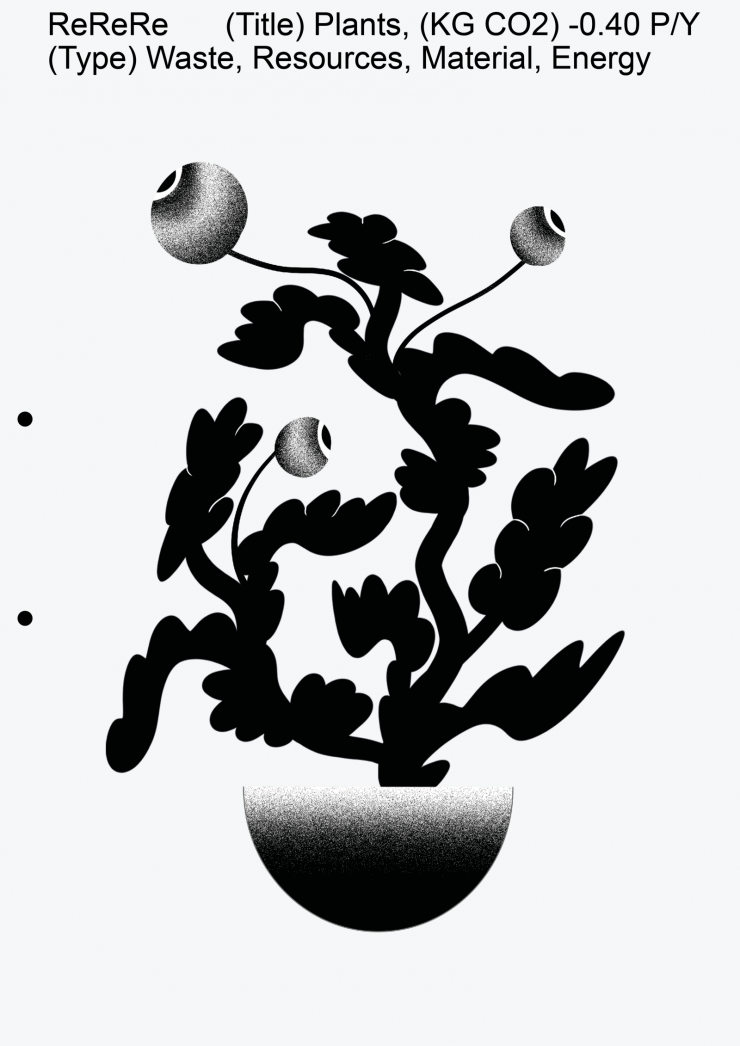
(ReReRe) Plants
(Impact) -0.40 CO2 P/Y
(Date) 25.11.2022
(Author) Jennifer Nguyen
(Illustration) Shaima Moon
In 2021, there was a major spike in worldwide google searches on how to take care of plants. Decorating your homes with houseplants had become much more appealing. This started early in the pandemic likely as an attempt to bring some life to people’s homes in the midst of dark lockdown days. But do they really improve our air quality, or are they worsening our environment?
Rethink
The agricultural and horticultural sectors play a very crucial role, considering they account for 10% of the Dutch economy and employment. In the second quarter of 2021, Dutch agriculture and horticulture emitted 1.8 megatons of CO2 and 4.6 megatons of other greenhouse gases. That totalled to 16.6% of the national emissions of greenhouse gases.
Our plant collections are part of a multi-billion Euro industry that can only stay afloat with massive amounts of resources in order to grow and transport these plants. In the production chain of these house plants, the biggest source of carbon emissions comes from large scale greenhouses. The latter is necessary to maintain plants under the correct heat and lighting conditions. This is where there is an intensive use of energy and water.
These plants are usually grown in industrial farms that are located in different parts of the world. Plant miles shoot up just to get these plants from point A to point B. Buying new plants also contributes to the amount of single-use plastics that would end up in landfills, from its packaging to plastic pots.
Additionally, certain additives to the potting mix of these plants are extremely consequential for the environment. Your houseplants were likely grown in peat moss and pesticides. While peat can protect the environment by effectively absorbing and storing carbon, it is becoming more scarce due to deforestation and excessive use. As a consequence, with its depletion, when peat bogs are damaged, they emit at least 2 billion tonnes of carbon dioxide annually.
Moreover, pesticides are used to keep the plants green and perfect, without any flaws. As a matter of fact, pesticides emit nitrous oxide — a greenhouse gas that warms the atmosphere 300 times more than carbon dioxide.
Repurpose
Despite the considerable impact of the industry, the Dutch government expresses their aim for the horticultural sector to be climate-neutral in 2040. While this initiative shows great promise for our environment, we as individuals are able to do our part to accelerate the energy transition.
Being mindful of how you procure your new plants is a first starting point. You can be considerate of your plant miles by buying locally, from stores whose plants are not grown in mass quantities in industrial farms. You can do research to make sure plants did not need to travel hundreds of kilometres just to get to a seller near you.
To avoid purchasing new plants altogether, you can propagate plants yourself from seeds or cuttings.
Another thing you can do is opt for more sustainable alternatives when it comes to composts, insecticides and pots for your plants. There are multiple viable substitutes for peats such as fibrous coconut coir and biochar — carbon and ash residues. You can also steer away from pesticides by choosing something more organic — a simple soap-water mix can do wonders to get rid of those unwanted bugs.
Let’s also not forget how important it is to reduce, reuse, and recycle! To prevent excessive waste, you can simply choose to reuse plastic pots that your new plants come in, or go for biodegradable pots.
Redesign
Like many other offices, we also want to make our working spaces cosier and a touch of greens in every corner of the room sure does the job. Although, we do not want to prioritise our comfort over the well-being of the environment. We believe that it is possible to have a beautifully decorated office space or home, without it being detrimental to our planet.
A large quantity of plants are not up to the market’s standards and are either left on the shelves or thrown away. We do not want to contribute to the amount of waste that goes into the plant trade because of aesthetic demands.
That is why we have supported Plantje.nl’s Groene Kneusjes boxes. These are ‘bruise’ boxes full of plants that are cosmetically flawed and of lesser quality, that not many people want to have. Thanks to this initiative, they have managed to save more than 1 million plants from going to waste! We’ve also adopted plants from our studio manager’s cuttings, who has a whole propagation station at home. Meanwhile, we’re propagating our larger plants too. Feel free to come to our studio and adopt, rather than shop!
#rerere is our action program to rethink, repurpose and redesign our social and ecological footprint for the better. you can find all our #rerere’s in our online logbook soon. We hope that it inspires you to take action. because the only way to create a future that includes you plus new generations to come is when we all take action. #timeisup
#rerere is our action program to rethink, repurpose and redesign our social and ecological footprint for the better. you can find all our #rereres here. We hope that it inspires you to take action. Because the only way to create a future that includes you plus new generations to come is when we all take action. #timeisup